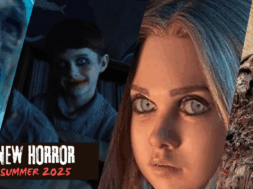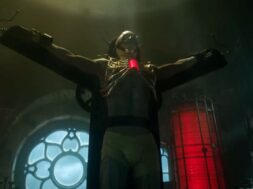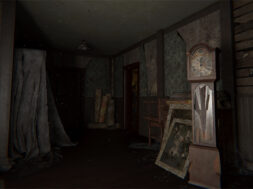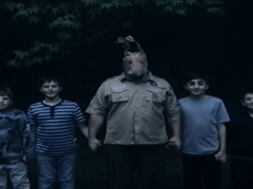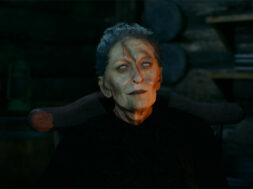Ten years ago, Paranormal Activity hit theaters and instantly became a massive sensation. The story of a couple documenting their haunted house on video camera struck box office gold and scared audiences across the world. And rightfully so – found footage may not be for everyone, but there is no denying that Oren Peli did something special and created a film that is a uniquely terrifying viewing experience.
In 2009, the Saw franchise was beginning to wind down and studios were looking for the next property that would become a horror staple. Something they could continue on and release in new installments every Halloween. Something that would be a huge moneymaker and box office draw, and would send audiences home cheering and shaking. They found that in Paranormal Activity.
Though the original film told a contained story, over the course of multiple sequels, the series would go on to develop a complicated mythos that would include a coven of witches, a not entirely thought out prophecy and would incorporate a number of different characters and new families into this tale. With each new film came some new revelation about the history of Katie and her sister Kristi, the nefarious plans of the coven and the entity that would eventually come to be known as Toby. Some of the sequels worked well and maintained the low budget, DIY feel of the original, and others, less so. But with every new chapter, everything that worked about Peli’s original film would come to be watered down in the name of finding a new angle to give audiences for every October release date.
A number of factors converge to make the original Paranormal Activity so effective, but it all comes down to the simplicity at the heart of the film. Paranormal Activity works well because it is a very simple tale. A couple begins noticing some odd occurrences in their home after they go to sleep, so they set up a camera to document their room at night, hoping to catch something strange on video (and they do).

The first film works in a way that many of its successors don’t in that the plot is minimal. Normally, that would probably be a bad thing, but here, it works. It strengthens our belief in the premise of the film and it allows the individual moments to shine without being bogged down in too much backstory. We learn, along with Katie and Micah, about the strange happenings that go on in their home at night. We start with low level occurrences that might be deemed weird or creepy and we watch over the course of a couple of weeks as they intensify to something flat-out terrifying.
But we don’t ever learn very much about the entity that is plaguing them. It didn’t yet have a name. It didn’t yet have a purpose. We eventually come to learn that it has been a part of Katie’s life since childhood, but we don’t know the how or the why. It’s this “not knowing” that makes Paranormal Activity such an enthralling and terrifying film. It’s so much more frightening than an overblown backstory. Here, there is no hidden secret or an overarching sinister plot. It’s just the story of two people living in a haunted house and trying to cope with something that is entirely outside of their understanding and control.
Most of the ghost stories that we grew up with, be it a classic piece of folklore, a chapter from “Scary Stories to Tell in the Dark”, or the neighborhood yarn of the creepy old house down the block – they are all pretty simple stories. The details are never pinned down and we rarely know much about the monster at all – it’s the idea of it that scares us the most. The idea, and what is left to our imaginations are enough to keep us up at night and make the story feel all the more real. And because of this, so does the plot of Paranormal Activity. It’s easy to get lost in this story because it fits that framework so well, and it doesn’t get too caught up in the details. Instead, it focuses on the scary scenes and lets those take center stage.
Added to that is the fact that the film was made on a tiny budget and had to utilize very basic effects and scare tactics. Those could have given the film a cheap look and feel, but instead, they helped to support the found-footage aesthetic. We settle very comfortably into the idea that we are watching the video that Micah and Katie made in their home and quickly forget that we are in a theater, surrounded by a hundred other people, watching a movie. We never see the entity, beyond the very rare glimpse of a moving shadow, and the scares, while frightening, are not terribly complicated. So there is little onscreen to remind our brains that what we are seeing was generated by a computer or some other level of movie magic. We more readily accept that what we are watching is real.
Peli’s use of pacing is another aspect that really works in the film’s favor. It’s a simple tool, but a highly effective one. It sets up a rhythm very unique to this film and helped to raise and lower the audience tension throughout the story. Almost all of the scary moments in the film happen at night, with daytime hours offering moments of respite. Every day, we know that we are, for the moment, safe. And at the end of every day, Micah and Katie get ready for bed and we know that something is likely to happen under cover of darkness.
Additionally, the camera uses a great trick to amplify this pacing and to set up a very palpable sense of dread. Every night as Katie and Micah sleep, the footage begins to fast forward, skipping forward through the hours they spend peacefully at rest, and bringing us closer to whatever strange event awaits them that particular night.
The time is captured on the camera’s counter, and the audience feels a sense of security as the numbers rush past – hours and minutes counting up toward morning. At some point though, the numbers will begin to slow, until the footage finally begins displaying in real time. It’s a cue to the audience that the hours or minutes of safety are at an end and that something frightening is about to take place. It might be small, or it could be major, but we are now tense and on the alert.
When morning once again arrives, we, like our characters, are able to breathe a sigh of relief. It’s easy to set aside the frights that took place in the shadows when the sun is shining and we are reviewing the recorded footage from the night before, trying to find a rational explanation for what happened. But when the brief respite is over, we once again find ourselves back in the darkened bedroom and are waiting tensely for the footage to once again slow.
The impact that Paranormal Activity had on horror cinema is undeniable. And though the series as a whole offers some interesting and even successful sequels, something about Peli’s first film remains particularly effective and special. It’s no surprise that such a financially successful film would spawn a franchise, but the first film is a good reminder that not every story needs a complicated mythology. Sometimes, the most effective movies are the ones that remind us just how frightening a darkened room can be.




